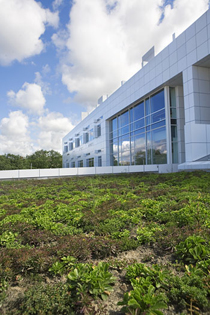COVER STORY SIDEBAR
By going green, Weill Hall meets the gold standard

Weill Hall's living green roof.
See larger image
In the world of finance, green is as good as gold. So it is with environmentally friendly construction standards. And as a result, Weill Hall has become one of only six university laboratory buildings to be gold certified by the Leadership in Energy and Environmental Design (LEED) Green Building Rating System, as judged by the U.S. Green Building Council.
"The LEED gold certification is a welcome recognition of Cornell's leadership in creating an environmentally friendly, sustainable campus," said Cornell President David J. Skorton. "The new building is a testament to the extraordinary skills of [architect] Richard Meier and highlights the university's commitment to sustainability in our academic initiatives and in our institutional stewardship."
Originally the building's plans met LEED silver standards, but as construction progressed, Weill Hall reached the gold standard, in part because it will use 30 percent less energy than a standard building of the same size.
The building features a living "green roof," where plants absorb rainwater runoff, reduce heating and cooling costs and filter out airborne pollutants and carbon dioxide. Highly efficient plumbing fixtures and a gray-water reclamation system reduce the building's annual wastewater generation by more than 40 percent, about 450,000 gallons a year, compared with a standard building.
In addition, more than 65 percent of construction waste was recycled or reused, and more than 60 percent of the wood products used in construction originated from sustainably managed forests.
Cornell's Lake Source Cooling project also greatly reduces the energy required to cool the building, saving more than 880,000 gallons of water annually that would have been lost by a traditional cooling system.